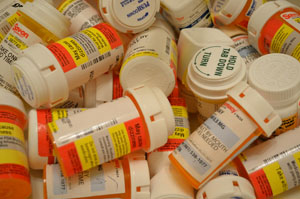About 50 Americans die every day from a prescription drug overdose — a tally that, in most states, turns out to be more than deaths from car accidents.
In a new report, “Prescription Drug Abuse: Strategies to Stop the Epidemic,” researchers at the Trust for America’s Health found that rates of overdose and addiction doubled since 1999 in most states. In West Virginia — the state with the highest number of drug overdose deaths — the rate was six times higher than fourteen years ago.

Photo by Erin DeMay/For KHN
During a conference call on Monday, the researchers said the emergence of prescription drugs like oxycodone has benefitted many people but is also marked by a corresponding rise in misuse.
“Working on this report, we were overwhelmed by the number of sad stories of tragedies that could have been averted,” said Jeff Levi, executive director of the Trust for America’s Health.
He said intervention strategies — ranging from the education of health providers to the correct disposal of unused medications — are proven solutions. The Trust for America’s Health, along with other public health and law enforcement experts, reviewed national recommendations and examined a set of 10 indicators that were having a positive impact, including certain laws and educational initiatives.
But most states had in place six or less of the indicators that help curb the issue. Only New Mexico and Vermont had all 10 strategies touted by the report. South Dakota had the lowest number: two.
Levi also said a Medicaid expansion in the 24 states and District of Columbia that are expanding the federal-state health insurance program for low-income people will lead to expanded coverage of substance abuse and treatment.
Meghan Andreae, a senior case manager at the addiction services and consulting firm Southworth Associates, said many clients become addicted to painkillers first through legitimate prescriptions for a health concern but later seek out new doctors and methods to obtain the drugs.
This issue highlights the need for more awareness among physicians — one of the strategies outlined in the report — since only 22 states have laws that require or recommend continuing education for doctors and other health providers who prescribe prescription pain meds.
“I would certainly say that’s something that’s lacking,” Andreae said. “A small amount of their training is spent on this issue.”
While the report highlights the shortcomings of prescription drug abuse prevention, it also recognizes that many states are taking steps to address the issue. Almost all state Medicaid programs have in place a pharmacy “lock-in” program that requires patients to use a single prescriber or pharmacy if they are suspected of abusing drugs. And, in 44 states, health providers have to conduct a physical exam and screen for substance abuse before prescribing medication.
Other recommendations include:
- Good Samaritan Laws — Measures that protect individuals from criminal charges for helping themselves or others experiencing an overdose.
- ID Requirements — Laws requiring or permitting a pharmacist to require an ID before dispensing a controlled substance.
- Rescue drug laws — Laws to expand access to the use of naloxone, a drug that can be effective in counteracting an overdose.
“Given the extraordinarily rapid growth of the problem, we’re also impressed by how quickly policies have emerged to get a handle on it, and how quickly many of these are showing signs of progress,” said Andrea Gielen, director of the Johns Hopkins Center for Injury Research and Policy, who was a reviewer of the report.






